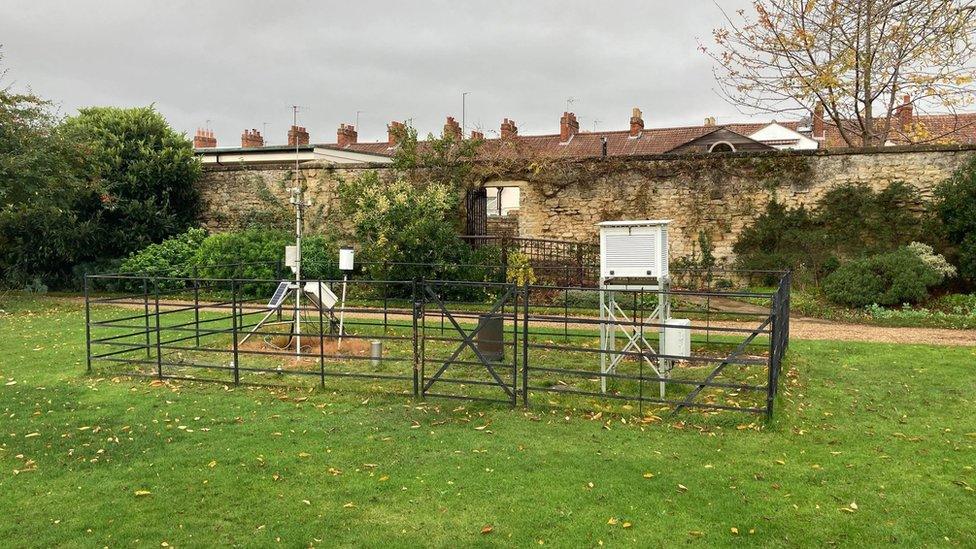Oxford: The soggy view from UK's oldest rain record
- Published

David Crowhurst measures rainfall in front of Oxford's Radcliffe Observatory
Last month was a particularly mucky and murky one amongst the "dreaming spires" of Oxford, as the city experienced its wettest October in 145 years.
Data collected at the Radcliffe Observatory recorded 185.3mm of rain.
Not only was that the highest monthly total observed on the site since 1875, it was also the fourth wettest of all months since records began in 1767.
The Radcliffe Meteorological Station, external holds the longest, continuous, single-site precipitation data-set in the UK.
Its rain gauge is positioned in a pen close to the majestic neoclassical observatory building in the gardens of Green Templeton College. And even in this age of automation, the instrument is still read by eye every morning.
Currently, this task falls to Keble College doctoral student David Crowhurst.
"We had an intense start to the month which was driven by Storm Alex, which saw 60mm falling on one day, the 3rd. That was quite something," he told BBC News.
"But we also had 27 rainy days in the month. A rainy day is when rainfall is equal to or greater than 0.2mm per day, and those 27 rainy days are a record for an October."

Punting weather: Flooding was extensive in the Oxford floods of October 1875

It rained pretty much everywhere on 3 October - not just in Oxford. The UK Met Office says that Saturday was the single wettest day for the country as a whole since daily record keeping began nationally in 1891.
Unsurprisingly with so much rain, the Radcliffe station recorded only 70.7 hours of sunshine through October - an exceptionally low number at over 30 hours below the monthly average.
Interestingly, Oxford's all time wettest October in 1875 was accompanied by extensive flooding in the city. That wasn't repeated last month, despite the less than 4mm difference in rainfall totals.
This may have something to do with the lower moisture content of soils following a relatively dry September. It would have meant the ground being better able to hold on to rainwater. But the absence of flooding on a similar scale almost certainly also reflects today's improved management of watercourses.
The very wet October continues a year of exceptional weather in Oxford, following the sunniest May since records began.
As for the coming months, David Crowhurst is watching closely the developing La Niña phenomenon in the Tropical Pacific.
This is a pattern of altered pressure and winds that leads to cooler sea-surface temperatures off the western coast of the Americas. Although thousands of km away, these conditions can have a profound influence on Britain's weather.
A strong La Niña, external could see some crisp clear days in the weeks ahead, followed perhaps by some more wet weather by the end of winter.

Top 10 wettest months at the Radcliffe Meteorological Station
Sep 1774 223.9mm
Nov 1770 192.4mm
Oct 1875 189.0mm
Oct 2020 185.3mm (7.3 inches)
Nov 1852 175.7mm
Nov 1940 175.7mm
Jul 1834 174.8mm
Sep 1768 170.9mm
Jun 1852 170.4mm
Nov 1929 165.9mm
Note: These are monthly records. The continuous daily record at the Radcliffe is unbroken from 1827


The UK as a whole experienced its wettest day on record on 3 October
Meteorology at the Radcliffe goes back to the pioneering 18th-Century studies of Prof Thomas Hornsby, a fellow of Corpus Christi College.
He was an astronomer, but to view the stars properly through his telescope, Hornsby also needed to make corrections for atmospheric disturbance, and that meant keeping a keen eye on the weather.
Some of his early documentation has been lost, and in the twilight of his career, Hornsby also got a bit haphazard in his observations. But the monthly rainfall totals he started are continuous from 1767.
Maintaining long, unbroken data-sets is extremely important for understanding climate trends.
It's time series like the one assembled at the Radcliffe that give us context, and the confidence to make projections about where the weather and the climate may be going in the future.
All the data indicates the globe is warming and the physics tells us that a warming atmosphere can hold more water.
Prof Richard Washington, the director of the Radcliffe Meteorological Station, told BBC News: "The UK Climate Projections note that the decade 2009-2018 was on average 1% wetter than 1981- 2010 and 5% wetter than 1961-1990 for the UK overall.
"Winters have followed a similar but more marked trend, such that the decade 2009-2018 was 5% wetter than 1981-2010 and 12% wetter than 1961-1990.
"Those are stark numbers. For many of us, though, they are hard to imagine. It is the union of weather and climate instead that turns out to be more tangible and interesting.
"What we witnessed on a day to day basis in October 2020, complete with its 27 rain days in Oxford, is how we might expect a wetter future to look. The weather has been unrelenting and the climate promises more."

The station is in the gardens of Green Templeton College
The Radcliffe Meteorological Station's full history and all its data were published last year in a book, Oxford Weather and Climate since 1767, authored by Stephen Burt and Tim Burt.